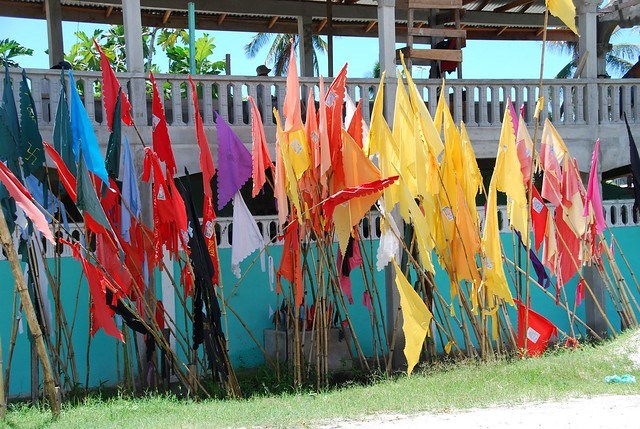The Jhandi is a common sight in the Hindu home as they can be seen next to the family’s private temple or their place of worship. It is usually a bamboo pole carrying flags of different colours; each colour would typically represent a deity and have a picture of the deity as well. They are usually placed and erected after prayer ceremonies and poojas have just been carried out.(1) “Today Jhandis may not serve the same social purpose but it does continue to indicate the Hindu presence. It makes a statement of cultural and religious identity. In addition, the hoisting of a flag is generally a symbol of victory over an enemy. The Jhandi is no different.” The Jhandi more or less represents the individual’s victory over lower values with higher ideals and values that were obtained through prayer. This is the basic concept behind doing pooja worship, to ascend and rise into divine qualities. There are poojas that emphasise certain aspects such as prosperity, education and understanding and these are some of the divine qualities that are being referred to. Most Hindus have a prayer ceremony or a small pooja at their home at least once per year where they would plant their Jhandis because a pooja would be considered to be complete without the use of Jhandis.
The presence of of the Jhandi specifies a “sankalp” which is a ‘covenant’; a spiritual commitment to faithfully live the value and messages enshrined in the life of the particular deity represented by the Jhandi. A perfect example of this would be a Hindu who plants a Jhandi for Mother Sarswati is hoping to get a better education in their life. (2)“A Hindu who plants a Jhandi for Mother Lakshmi is committing to becoming an adequate provider for the family and the community, just as Mother Lakshmi is the provider of the material sources to Lord Vishnu who in turn uses those resources to sustain the universe of beings.” The Jhandi is also a symbol of visible commitment and in the house that it is flown in signals to the public that the householder has become aware of their life and is now looking for change by committing noble practices. There are a few reasons that bamboo is used to hold up the Jhandi.(3) “I am sure that there are references to the bamboo in the description of Hindu rituals which name the bamboo as the tree to be used to plant a Jhandi. My own understanding leads me to advance two reasons as to why bamboo is used to plant a Jhandi. Firstly, it is tall and straight and secondly it is long lasting. These both reasons can be tied to the symbolism of the bamboo in both the reasons that were just mentioned. Before the Jhandi is placed in the ground, the picture of the deity being worshipped in a triangular design is placed at the top of the Jhandi. The picture of the Hindu deity placed on the Jhandi is considered to be sacred and given the highest level of respect. As it is sits upon the top of the bamboo pole, the Jhandi sits as a symbol of reverence; it signifies the Hindu home’s love of god and that they acknowledge of the Highest and most Supreme Being. The straightness of the bamboo also signifies the upright life that devotee is expected to carry out to the deity depicted on their Jhandi. The hole that Jhandi is placed is first placed in is placed with milk and other grains and this is used to symbolize the human body.
“The base of the bamboo represents the human feet, the top the human head, with its thought mind, mind and intelligence to choose. The Jhandi placed in a hole filled with milk and other grains represents the commitment of the human being to stand deeply and firmly on the pillar of purity (milk), supporting the highest moral and spiritual principles (flag at the top), and committing to make choices that upholds the values which the propitiated deity represents.” For the Hindu devotee to fully benefit from the pooja performed the individual must live and conform to the teachings of the prayer that he has just done and some of these values are righteousness, integrity and truth amongst others. The planting of the Jhandi also symbolizes a commitment to life and by placing it into the hole with milk, the devotee is going to stand firm on these values. (4)“ if one considers that the top of the bamboo pole where the flag with the picture of the deity is flies, is representative of the head that should be used to make intelligent choices, one then clearly understands that in putting a Jhandi once committing a mental and physical transformation towards divinity. When one’s life is founded in purity, one chooses nobly!”
The entire ritual of placing the Jhandi goes through several stages, the first of which a cloth that is tied around the bamboo. This symbolizes the raksha (cord) tied around the devotees wrist while they are doing pooja and the cord itself symbolizes a cord of protection and a cord of commitment. This cord represents protection against any evil temptations and it’s a commitment to eliminate evil and uphold righteousness in the world. Sindoor (red powder), Chandan (white powder) and Hardi (yellow powder) are placed on different points of the Jandhi and and the bamboo. The sindoor represents commitment to be loyal to be devoted to the lord while chandan is placed on the head of murtis and devotees. It is also placed on other ‘parts’ of the persons head such as the side of ears to symbolize that the devotee will hear good things and try to turn a der hear to gossip. The chandan which is placed on the forehead of the individual is commonly called a tika and represents the spiritual eye and is used as a reminder that Hindu devotees must keep in contact the pursuit of Moksha which is freedom from sorrow. (5) ” When all the items are places on a straight bamboo pole with the flag attached to the top, and planted in a hole filled with milk and other grains symbolize an upright human being, deeply rooted in spiritual values, filled with devotion and humility and intelligently making life choices that support a god centred life.” The Jhandi is a practice that continues in Trinidad but has been stopped in India.
References :-
Credit: https://tnthinduhistory.wordpress.com/chapters/jhandis/
(1) Rambachan Surujrattan. National Council of Indian Culture Annual Commemorative Magazine 23rd Edition, Divali Nagar 2009. The Hindu Concept of God. Pg 24,
(2)Rambachan Surujrattan. National Council of Indian Culture Annual Commemorative Magazine 23rdEdition, Divali Nagar 2009. The Hindu Concept of God. Pg 24,
(3) Rambachan Surujrattan. National Council of Indian Culture Annual Commemorative Magazine 23rd Edition, Divali Nagar 2009. The Hindu Concept of God. Pg 24,
(4) Rambachan Surujrattan. National Council of Indian Culture Annual Commemorative Magazine 23rd Edition, Divali Nagar 2009. The Hindu Concept of God. Pg 24,
(5) Rambachan Surujrattan. National Council of Indian Culture Annual Commemorative Magazine 23rd Edition, Divali Nagar 2009. The Hindu Concept of God. Pg 24,



Leave a Reply
You must be logged in to post a comment.